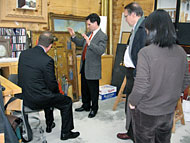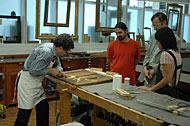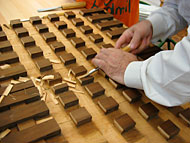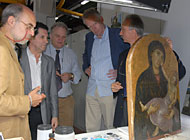The objectives of the Panel Paintings Initiative were to enhance understanding of the structural conservation of panel paintings; provide expertise in the structural stabilization of these works to a new generation of conservators through education and training; and disseminate reference and learning resources on the structural conservation of panels.
In support of these objectives, the Getty undertook a range of coordinated activities:
- A two-day international symposium examining the challenges of panel paintings conservation
- Education and training activities, including residencies for conservators to acquire skills in panel stabilization and short-term workshops, and meetings focused on special topics related to panel paintings
- Related materials including symposium proceedings and video and a searchable bibliography
Background:
Panel Paintings Conservation: Paintings created on wood supports—known as panel paintings—rank among the most significant works of Western art made from the twelfth century onward, and today constitute a major part of American, European, and Russian museum collections. Paintings on wooden panels were common in Europe, especially in Italy and northern Europe. Wood panel supports were either constructed from a single piece of wood or, for larger paintings, from a number of pieces joined together. Panel painting remained common until the sixteenth century when canvas was increasingly used as a support.
Paintings on wood panels are highly susceptible to climatically induced structural damage. As an organic material, wood responds readily to changes in ambient temperature and humidity, absorbing and desorbing moisture as environmental conditions fluctuate. The absorption and desorption of moisture results in mechanical changes such as swelling and shrinking of the wood. Repeated cycles of swelling and shrinking—often occurring over centuries—will cause panels to warp, twist, or split. This type of damage to a painting's substrate can, in turn, have a deleterious effect on the paint layer, potentially resulting in paint loss.

|
|
Over time, attempts to stabilize the movement of panels—inhibiting their deformation and consequent damage to the paint layer—have led to a number of structural treatment approaches. These treatments have included thinning the wood panel and attaching a rigid structure or cradle or, in some cases, removing the wooden substrate completely and transferring the paint layer to canvas. However, the development of the conservation profession in more recent decades has led to a greater sensitivity to the character of the substrate and the construction of the painting, which in turn has led to less invasive treatment of structural problems.
A Scarcity of Experts: Although the structure of panel paintings and the different behaviors of the wood and paint layers have long posed a challenge to conservators, today only relatively few in the conservation field have the experience necessary to deal with these structural issues. The scarcity of experts is made urgent by the fact that some of the few active panel restorers—many of whom are craftspeople trained in traditional woodworking skills—will likely retire over the course of the next two decades. It is therefore imperative to create opportunities for younger professionals to acquire skills from their more experienced colleagues.
Overview
To address this challenge, the GCI, the Getty Foundation, and the Getty Museum joined together to develop the multi-year Panel Paintings Initiative, which was designed to increase specialized training in the structural conservation of panel paintings and to advance the treatment of these works in collections around the world. The initiative also aimed to raise general awareness of panel painting conservation among painting and wood conservators, curators, and scientists. The initiative built on a previous symposium on panel paintings that was organized by the Getty Museum and the GCI in 1995.
 |
 |
|

|
|
The Foundation, GCI, and Museum jointly launched the new initiative in February 2008 with a planning meeting at the Metropolitan Museum of Art, New York. Project development continued with team members meeting at the Opificio delle Pietre Dure—one of the few institutions that currently offers specialized training in panel paintings conservation—in Florence in June 2008. Guided by an international advisory group the work of the initiative was carried out in partnership with individuals and institutions with a long history of panel paintings conservation.
Page updated: August 2019